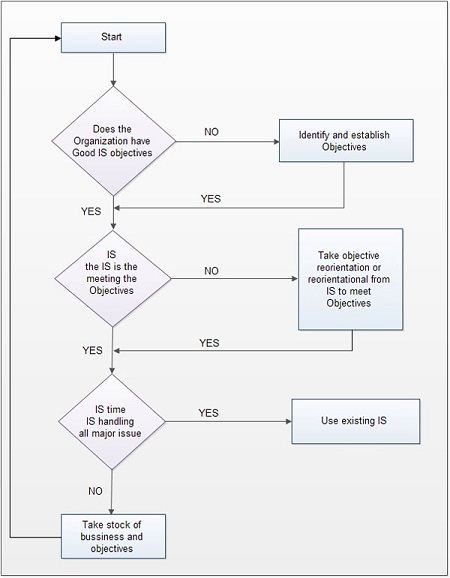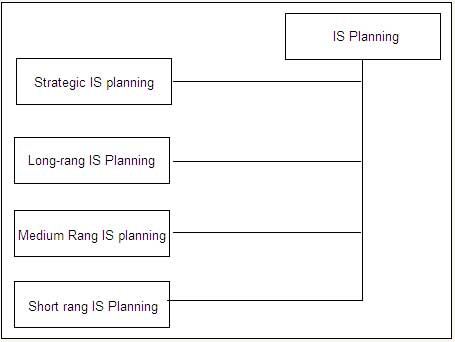Planning is the key to success in developing a good IS. IS planning brings to focus the reason for existence of the IS and helps the developers to undertake the task of development of IS in a structured manner. Organizations undertake planning for IS for several reasons. Typically IS, plans have a hierarchy with different levels of management handling different plans.

Strategic Information Systems Planning
This is the first plan of information systems within an organization. It is foremost for defining the role information systems will play in the overall scheme of things. Typically, top management formulates a charter for information systems or the CIO formulates the charter and gets approval of the top management. With the charter, the mission of information system in the organization is also formulated. Thereafter the constraints and environment in which IS is to be implemented is analyzed. In this, the strategic objectives, policies, human resource, maturity of IS usage of the organization and the present and future information needs of the organization in view of changes in technology is analyzed. Following the broad mission and analysis of environment and constraints, concrete objectives of information systems is laid down along with the plan of achieving the objectives. The plan will include broad guidelines on allocation of resources, mechanisms of control of the process of information system development and other guidelines for implementing the strategies of the plan.
Long Range Information System Planning
This is the second stage of planning done primarily to understand the user needs and objectives. This sort of plan does not go into project specific details but rather focuses on the expectations of users from the system. Typically, this kind of planning is done with a time horizon of five to ten years in mind. Broad characteristics of information systems based on the needs of the users are dealt with in this plan along with the technology trends in the information technology space and long-term objectives of the organization. The long-term plan requires greater detailing than a strategic plan and is normally prepared by senior executives in the organization which is then approved by the top management. Ideally, senior executives from different departments are involved in this process. The following step-wise course of action is normally taken to prepare a long-range information systems plan:
Collecting background data
All kinds of data that helps in creating a background or perspective for the planning with regard to the technology scenario, organization objectives, changing needs of the users, competition scenario, potential set of information services in future, availability of resources in future, suitability of organizational culture, etc., is collected and presented as a background.
Analyzing the broad long-term needs
Based on the prepared background, analysis of the overall long-term information system need of the organization is defined. This entails an analysis of demand on resources for such information systems and the means to provide them.
Developing the long-range plan document
Formally documenting the above steps into a plan of action results in the creation of this document. This document typically contains information about the objectives, resources to be made available for the IS, future trends in demand for information within the organization, risks and opportunities in developing the IS and organizational issues pertaining to installation of such IS.
The medium-range information systems planning
This is a very important plan for developing the IS. It looks to satisfy the present information needs of the organization by implementing a portfolio of projects. The planning time horizon is one to two years and the focus is on the present. It normally contains the plan of action for the portfolio of IS projects, resource requirements for each, procurement of necessary resources for implementing the projects, staffing needs analysis, budgeting and funding issues, priority setting of the projects under development. This process of planning, resulting in the information systems, master plan document containing details on:
- The present IS situation with regard to usage, ·technology, work force and other resources.
- Analysis of the present IS situation.
- Plan of action including prioritization of projects aligns it with the long-term plan of IS.
- Policies under several operational heads like training, procurement, hiring, outsourcing, and security are given in these documents.
- Financial implications.
- Risk to projects.
- Process of development and present status of each project under development.
The short-range information system planning
The time horizon for such a plan ranges from a few months to a year. Operational details and short-term goals and objectives are detailed out in this document. Normally the personnel of the information systems department are involved in the preparation of such a plan. It includes maintenance plan for existing systems, development plans for top priority systems, technical support required for the development, operations plan, training plan, staffing plan and financial plan containing practices and procedures for relevant issues, all in the short term of about a year.

 Dinesh Thakur holds an B.C.A, MCDBA, MCSD certifications. Dinesh authors the hugely popular
Dinesh Thakur holds an B.C.A, MCDBA, MCSD certifications. Dinesh authors the hugely popular